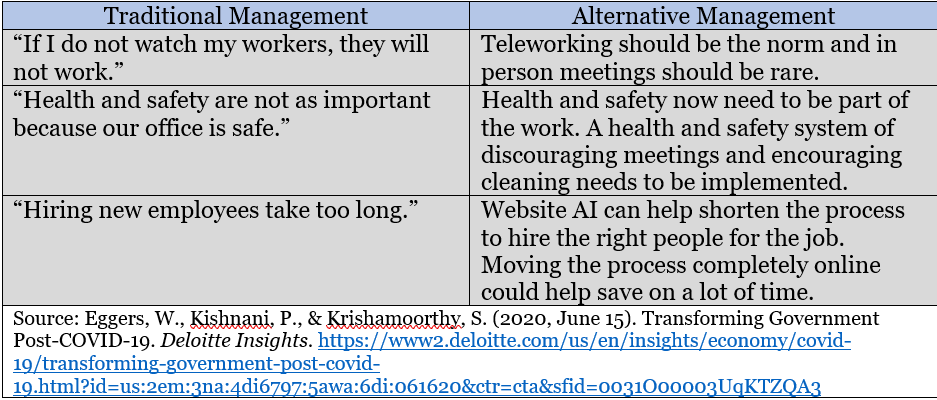Despite the pandemic’s disruption of normal work life, innovation can still take place. A disruption can often be the catalyst of systemic change. This is because in a disruption, there is a push to quickly fix inefficiencies within the system. The main killer of innovation is often habit. The COVID-19 pandemic has disrupted businesses and government across the country, but it doesn’t mean your office cannot capitalize on the opportunity for innovation. Although the COVID-19 pandemic is unprecedented, the techniques used to fuel innovation from disruption are still applicable today.[1]
Treat the Pandemic Like a Work Hazard
The first thing you need to do is create a sense of safety. Your workers cannot innovate if they do not feel safe. The American Society of Public Administration explains that if workers do not feel safe, they will be constantly distracted by the urge to fulfill their safety needs instead of thinking of their work.
Even before the pandemic, workplaces had to navigate work hazards such as factories with heavy machinery, banks that run the risk of being robbed, or even restaurants whose employees are around hot stoves. Harvard Busines Review (HBR) discusses the main reason why these workplaces are able to be successful day-to-day and still innovate, is because they make sure their workers are not just safe but that they feel safe. HBR gives specific guidance on a number of initiatives that bring front-line worker and management together to accomplish this. These workplaces offer Central Procurement Officers inspiration and ideas for how to mitigate fears of the pandemic in the office.
Innovation is Already Out There
In the midst of the pandemic, many government agencies have begun innovating their workplaces. These opportunities for innovation didn’t just appear out of thin-air, but identified by flipping the ideas of traditional government management.

Not Everyone is an Innovator, but Innovation Can Come from Anywhere
Innovation does not just come from the top. It is important to engage with front-line workers and get their perspectives on what can be changed. Insights on the day-to-day interaction with the front-line will prove invaluable in innovating the workplace.[2] The trust you built by promoting a safe workplace environment will encourage open discussion among your team. Safe workers will feel empowered to call attention to inefficiencies or problem areas.
Frontline government innovation is already happening due to the COVID-19 pandemic. The Centers for Disease Control and Prevention (CDC) and the U.S. Department of Veteran Affairs(VA) have tapped into artificial intelligence to help fight the pandemic. Both federal agencies created website bots that recommends when users should seek medical help for potential COVID-19 symptoms . These bots aim to keep the phone lines free for more complex questions. For procurement specific examples of government innovation see our George Cronin awards past winners.
As a profession, public procurement officials across the globe have seen the ripple effect of broken supply chains, and with a changing environment, central procurement officials must adapt to this new climate. Creating an interdependent system of trust and safety between you, management, workers, and being open to new ideas that break tradition can breed new ways of tackling this new normal.
- Power, B. (2013, December 10). For Cross-Functional Change, A Good Disruption Helps. Harvard Business Review. https://hbr.org/2013/12/for-cross-functional-change-a-good-disruption-helps
- Ashkenas, R. & Manville, B. (2019, April 4). You Don’t Have to Be CEO to Be a Visionary. Harvard Business Review. https://hbr.org/2019/04/you-dont-have-to-be-ceo-to-be-a-visionary-leader
